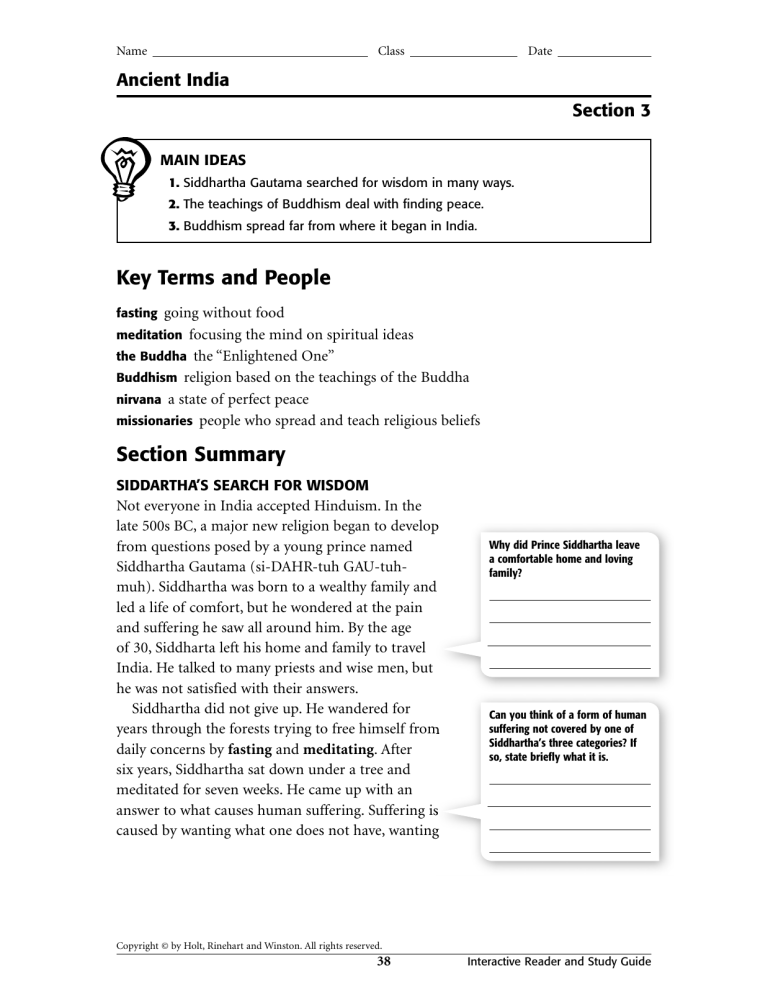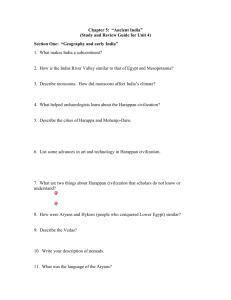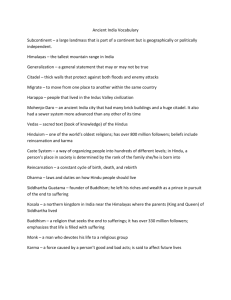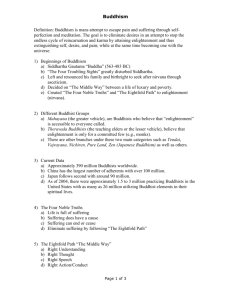Key Terms and People Section Summary

Ancient India
Section 3
MAIN IDEAS
1.
Siddhartha Gautama searched for wisdom in many ways.
2.
The teachings of Buddhism deal with finding peace.
3.
Buddhism spread far from where it began in India.
Key Terms and People
fasting going without food meditation focusing the mind on spiritual ideas the Buddha the “Enlightened One”
Buddhism religion based on the teachings of the Buddha nirvana a state of perfect peace missionaries people who spread and teach religious beliefs
Section Summary
SIDDARTHA’S SEARCH FOR WISDOM
Not everyone in India accepted Hinduism. In the late 500s BC, a major new religion began to develop from questions posed by a young prince named
Siddhartha Gautama (si-DAHR-tuh GAU-tuhmuh). Siddhartha was born to a wealthy family and led a life of comfort, but he wondered at the pain and suffering he saw all around him. By the age of 30, Siddharta left his home and family to travel
India. He talked to many priests and wise men, but he was not satisfied with their answers.
Siddhartha did not give up. He wandered for years through the forests trying to free himself from daily concerns by fasting and meditating . After six years, Siddhartha sat down under a tree and meditated for seven weeks. He came up with an answer to what causes human suffering. Suffering is caused by wanting what one does not have, wanting
Why did Prince Siddhartha leave a comfortable home and loving family?
Can you think of a form of human suffering not covered by one of
Siddhartha’s three categories? If so, state briefly what it is.
Copyright © by Holt, Rinehart and Winston. All rights reserved.
38 Interactive Reader and Study Guide
Section 3, continued to keep what one likes and already has, and not wanting what one dislikes but has. He began to travel and teach his ideas, and was soon called the
Buddha , or “Enlightened One.” From his teachings sprang the religion Buddhism .
TEACHINGS OF BUDDHISM
Buddhism is intent on relieving human suffering. It is based upon the Four Noble Truths. These truths are: Suffering and unhappiness are part of life; suffering stems from our desire for pleasure and material goods; people can overcome their desires and reach nirvana , a state of perfect peace, which ends the cycle of reincarnation; and people can follow an eightfold path to nirvana, overcoming desire and ignorance.
These teachings were similar to some Hindu concepts, but went against some traditional Hindu ideas. Buddhism questioned the need for animal sacrifice. It also challenged the authority of the
Brahmins. The Buddah said that each individual could reach salvation on his or her own. Buddhism also opposed the caste system.
BUDDHISM SPREADS
Buddhism spread quickly throughout India.
With the help of Indian king Asoka, Buddhist missionaries were sent to other countries to teach their religious beliefs. Buddhism quickly took hold in neighboring countries like Nepal, Sri Lanka, and
China. Buddhism soon became very influential in
Japan and Korea. In modern times, Buddhism has become a major global religion.
What is the name of the central teachings of Buddhism?
Buddhist texts often refer to “the compassionate Buddha.” Why is this term appropriate?
Name one way in which Buddhist doctrine is similar to democracy.
CHALLENGE ACTIVITY
Critical Thinking: Drawing Inferences Could you leave your family, home, and everything you know to preach what you believe to be a spiritual truth? You are preparing to follow the Buddha. Write a goodbye letter to your family explaining why you have chosen this life of sacrifice.
Copyright © by Holt, Rinehart and Winston. All rights reserved.
39 Interactive Reader and Study Guide









